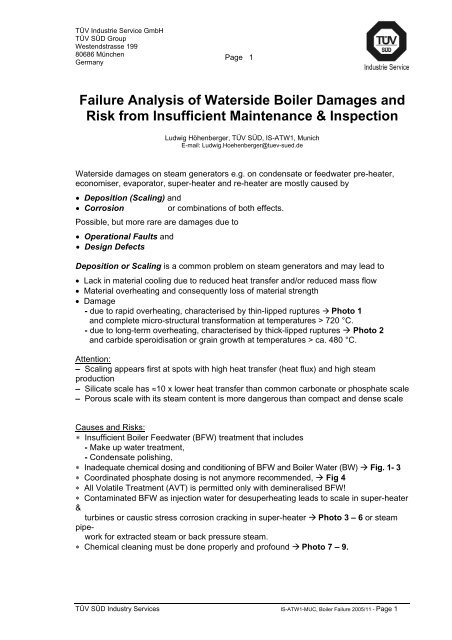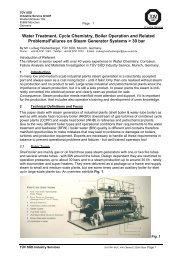Failure Analysis of Boiler Damages.pdf - Sme-gtz.org.vn
Failure Analysis of Boiler Damages.pdf - Sme-gtz.org.vn
Failure Analysis of Boiler Damages.pdf - Sme-gtz.org.vn
Create successful ePaper yourself
Turn your PDF publications into a flip-book with our unique Google optimized e-Paper software.
TÜV Industrie Service GmbH<br />
TÜV SÜD Group<br />
Westendstrasse 199<br />
80686 München<br />
Germany<br />
Page 1<br />
<strong>Failure</strong> <strong>Analysis</strong> <strong>of</strong> Waterside <strong>Boiler</strong> <strong>Damages</strong> and<br />
Risk from Insufficient Maintenance & Inspection<br />
Ludwig Höhenberger, TÜV SÜD, IS-ATW1, Munich<br />
E-mail: Ludwig.Hoehenberger@tuev-sued.de<br />
Waterside damages on steam generators e.g. on condensate or feedwater pre-heater,<br />
economiser, evaporator, super-heater and re-heater are mostly caused by<br />
• Deposition (Scaling) and<br />
• Corrosion or combinations <strong>of</strong> both effects.<br />
Possible, but more rare are damages due to<br />
• Operational Faults and<br />
• Design Defects<br />
Deposition or Scaling is a common problem on steam generators and may lead to<br />
• Lack in material cooling due to reduced heat transfer and/or reduced mass flow<br />
• Material overheating and consequently loss <strong>of</strong> material strength<br />
• Damage<br />
- due to rapid overheating, characterised by thin-lipped ruptures Photo 1<br />
and complete micro-structural transformation at temperatures > 720 °C.<br />
- due to long-term overheating, characterised by thick-lipped ruptures Photo 2<br />
and carbide speroidisation or grain growth at temperatures > ca. 480 °C.<br />
Attention:<br />
– Scaling appears first at spots with high heat transfer (heat flux) and high steam<br />
production<br />
– Silicate scale has ≈10 x lower heat transfer than common carbonate or phosphate scale<br />
– Porous scale with its steam content is more dangerous than compact and dense scale<br />
Causes and Risks:<br />
∗ Insufficient <strong>Boiler</strong> Feedwater (BFW) treatment that includes<br />
- Make up water treatment,<br />
- Condensate polishing,<br />
∗ Inadequate chemical dosing and conditioning <strong>of</strong> BFW and <strong>Boiler</strong> Water (BW) Fig. 1- 3<br />
∗ Coordinated phosphate dosing is not anymore recommended, Fig 4<br />
∗ All Volatile Treatment (AVT) is permitted only with demineralised BFW!<br />
∗ Contaminated BFW as injection water for desuperheating leads to scale in super-heater<br />
&<br />
turbines or caustic stress corrosion cracking in super-heater Photo 3 – 6 or steam<br />
pipe-<br />
work for extracted steam or back pressure steam.<br />
∗ Chemical cleaning must be done properly and pr<strong>of</strong>ound Photo 7 – 9.<br />
TÜV SÜD Industry Services IS-ATW1-MUC, <strong>Boiler</strong> <strong>Failure</strong> 2005/11 - Page 1
TÜV Industrie Service GmbH<br />
TÜV SÜD Group<br />
Westendstrasse 199<br />
80686 München<br />
Germany<br />
Deposition or Scaling may also lead to<br />
Page 2<br />
• Localised concentration <strong>of</strong> impurities within or underneath <strong>of</strong> deposits at heated<br />
surfaces<br />
• ”On Load Corrosion” with acidic or alkaline attack Photo 10 – 12.<br />
Attention:<br />
– Scaling appears first at spots with high heat transfer and high steam production<br />
– Even non corrosive deposits e.g. Photo 13 - 20<br />
- iron oxides may lead to porous, thermal critical scale,<br />
- silicates as Ca-, Mg, Al-silicates to over-heating<br />
– <strong>Boiler</strong> operation according to the BFW and BW requirements for some years lead<br />
mostly<br />
to some deposits <strong>of</strong> iron oxide, which should be preventively removed<br />
Causes and Risks:<br />
∗ Insufficient on-line quality control <strong>of</strong> make-up water, condensate return or BFW<br />
∗ Measurement <strong>of</strong> “Acid Conductivity” amplifies detection <strong>of</strong> ingress <strong>of</strong> impurities like<br />
cooling<br />
water and some process media but do not indicate ingress <strong>of</strong> free caustics!<br />
∗ Lack in Inspection <strong>of</strong> not safety related components like heat exchangers and<br />
condensers<br />
∗ Preventive cleaning during operation or at shut down must be done according to the<br />
specifications<br />
Corrosion on boiler steel (carbon or low alloyed steel) can be mainly avoided, if the BFW<br />
and BW requirements were kept. Deviations may leads to<br />
• Dissolution <strong>of</strong> the important protective layer, material attack and loss in form <strong>of</strong><br />
- Uniform or General Corrosion or - more dangerous - to<br />
- Localised Corrosion (Pitting, On-load corrosion, etc.) Figs. 2 - 4<br />
• Crack formation in specific cases<br />
Attention:<br />
– Uniform or General Corrosion isn’t problem if the material loss is less than 0.1 mm/year<br />
(is easy to achieve with normal protective iron oxide layer)<br />
– Localised corrosion during operation underneath <strong>of</strong> deposits and within heated gaps as<br />
well<br />
as during stand still in form <strong>of</strong> oxygen corrosion (pitting formation)<br />
– Crack formation due to high concentration <strong>of</strong> free caustics in presence <strong>of</strong> high tensile<br />
stress (Caustic SCC) Photos 3 - 6<br />
Causes and Risks:<br />
∗ Insufficient BFW and BW composition, which do not meet the requirements <strong>of</strong> the boiler<br />
manufacturer or approved standards<br />
∗ Inadequate preservation during shut down<br />
∗ Localised concentration <strong>of</strong> acidic acting impurities e. g. cooling water or sea water<br />
ingress<br />
∗ Localised concentration <strong>of</strong> caustic acting impurities or free caustic underneath deposits<br />
within heated gaps or at heated phase boundaries<br />
TÜV SÜD Industry Services IS-ATW1-MUC, <strong>Boiler</strong> <strong>Failure</strong> 2005/11 - Page 2
TÜV Industrie Service GmbH<br />
TÜV SÜD Group<br />
Westendstrasse 199<br />
80686 München<br />
Germany<br />
Page 3<br />
∗ Caustic SCC in case <strong>of</strong> contamination <strong>of</strong> super-heater due to mechanical carry over <strong>of</strong><br />
BW<br />
or contaminated injection water for desuperheating Photo 3 - 6<br />
Corrosion due to non-corrosive BFW and BW conditions but elevated temperatures or<br />
distinct temperature fluctuations may lead to<br />
• Excessive Iron Oxide formation – particularly > 570 °C Photo 19 -20<br />
• Hydrogen production<br />
• Hydrogen damage that includes<br />
- Decarburisation<br />
- Hydrogen Embrittlement<br />
- Fissuring (micro cracks)<br />
- Sudden brittle rupture Photo 21<br />
• Thermo shock Photos 22 - 23<br />
Iron reacts very fast at temperatures > 570 °C with water or steam<br />
[1] Fe + H20 → FeO + 2 {H} to wustite (FeO) and atomic hydrogen {H}<br />
[2] 2 {H} → H2 that later recombines to molecular hydrogen<br />
(H2)<br />
Causes and Risks:<br />
Insufficient water (mass) flow e.g. due to<br />
– Steam/Water separation in tubes with low slope (Design problem) or<br />
– Too much refractory material (Design or repair problem)<br />
– Insufficient mass flow due to deposits within headers<br />
– Excessive localised heat input e. g. due to misalignment <strong>of</strong> burners<br />
Operational Faults may lead to <strong>Boiler</strong> / Super-Heater damages for instance<br />
• Short-term increasing steam production or over-load may lead to<br />
Fast pressure drop → Increasing BW level → BW carry over<br />
• Immediate boiler pressure drop may lead to<br />
BW carry over → steam contamination → super-heater/turbine damages<br />
• Operation significantly below design pressure leads to<br />
Increasing specific steam volume and poor steam/water separation that may lead to<br />
steam contamination → BW carry over → SH/turbine deposits<br />
• Quick start up from cold shut down may lead to<br />
- Thermal stress on components with thick wall thickness (may cause crack)<br />
- Local overheating due to insufficient BW circulation (lack in steam production)<br />
• Quick start up from hot stand by may lead to<br />
Local overheating due to insufficient BW circulation (lack in steam production)<br />
• BFW Temperature significant below design temperature may lead to<br />
- Material over-heating due to lack <strong>of</strong> steam production<br />
- Under cooled boiling (→ erosion corrosion, FAC)<br />
Design Problems may lead to several problems or damages, for instance<br />
• Low slope riser tubes (on the way to the drum) heated also from top may lead to steam/<br />
water separation → Steam-side tube over-heating → Loss in material strength →<br />
TÜV SÜD Industry Services IS-ATW1-MUC, <strong>Boiler</strong> <strong>Failure</strong> 2005/11 - Page 3
TÜV Industrie Service GmbH<br />
TÜV SÜD Group<br />
Westendstrasse 199<br />
80686 München<br />
Germany<br />
Page 4<br />
Steam-<br />
side excessive iron oxidation → Material loss → Hydrogen damage Photos 19 & 21<br />
• Heated down-comer tubes may cause circulation problems like stagnant flow →<br />
Insufficient<br />
water supply for riser tubes → Lack in cooling <strong>of</strong> evaporator tubes → Material overheating<br />
• Heavily fluctuating water level in the boiler drum may lead to<br />
Fluctuating steam space load and problems with the steam purity<br />
• Refractory material reduces heat input to evaporator tubes but may<br />
also affect the steam production and water circulation (mass flow)<br />
• Defects at drum internals e. g leaks at baffle sheets, incorrect installed demisters<br />
or cyclones may affect the steam purity<br />
Annexes: Photos 1 – 23<br />
Figures 1 – 4<br />
Photographs<br />
Photo 1<br />
TÜV SÜD Industry Services IS-ATW1-MUC, <strong>Boiler</strong> <strong>Failure</strong> 2005/11 - Page 4
TÜV Industrie Service GmbH<br />
TÜV SÜD Group<br />
Westendstrasse 199<br />
80686 München<br />
Germany<br />
Photo 2<br />
Photo 3<br />
Page 5<br />
TÜV SÜD Industry Services IS-ATW1-MUC, <strong>Boiler</strong> <strong>Failure</strong> 2005/11 - Page 5
TÜV Industrie Service GmbH<br />
TÜV SÜD Group<br />
Westendstrasse 199<br />
80686 München<br />
Germany<br />
Photo 4<br />
Photo 5<br />
Page 6<br />
TÜV SÜD Industry Services IS-ATW1-MUC, <strong>Boiler</strong> <strong>Failure</strong> 2005/11 - Page 6
TÜV Industrie Service GmbH<br />
TÜV SÜD Group<br />
Westendstrasse 199<br />
80686 München<br />
Germany<br />
Photo 6<br />
Photo 7<br />
Page 7<br />
TÜV SÜD Industry Services IS-ATW1-MUC, <strong>Boiler</strong> <strong>Failure</strong> 2005/11 - Page 7
TÜV Industrie Service GmbH<br />
TÜV SÜD Group<br />
Westendstrasse 199<br />
80686 München<br />
Germany<br />
Photo 8<br />
Photo 9<br />
Page 8<br />
TÜV SÜD Industry Services IS-ATW1-MUC, <strong>Boiler</strong> <strong>Failure</strong> 2005/11 - Page 8
TÜV Industrie Service GmbH<br />
TÜV SÜD Group<br />
Westendstrasse 199<br />
80686 München<br />
Germany<br />
Photo 10<br />
Photo 11<br />
Page 9<br />
TÜV SÜD Industry Services IS-ATW1-MUC, <strong>Boiler</strong> <strong>Failure</strong> 2005/11 - Page 9
TÜV Industrie Service GmbH<br />
TÜV SÜD Group<br />
Westendstrasse 199<br />
80686 München<br />
Germany<br />
Photo 12<br />
Photo 13<br />
Page 10<br />
TÜV SÜD Industry Services IS-ATW1-MUC, <strong>Boiler</strong> <strong>Failure</strong> 2005/11 - Page 10
TÜV Industrie Service GmbH<br />
TÜV SÜD Group<br />
Westendstrasse 199<br />
80686 München<br />
Germany<br />
Photo 14<br />
Photo 15<br />
Page 11<br />
TÜV SÜD Industry Services IS-ATW1-MUC, <strong>Boiler</strong> <strong>Failure</strong> 2005/11 - Page 11
TÜV Industrie Service GmbH<br />
TÜV SÜD Group<br />
Westendstrasse 199<br />
80686 München<br />
Germany<br />
Photo 16<br />
Photo 17<br />
Page 12<br />
TÜV SÜD Industry Services IS-ATW1-MUC, <strong>Boiler</strong> <strong>Failure</strong> 2005/11 - Page 12
TÜV Industrie Service GmbH<br />
TÜV SÜD Group<br />
Westendstrasse 199<br />
80686 München<br />
Germany<br />
Photo 18<br />
Photo 19<br />
Page 13<br />
TÜV SÜD Industry Services IS-ATW1-MUC, <strong>Boiler</strong> <strong>Failure</strong> 2005/11 - Page 13
TÜV Industrie Service GmbH<br />
TÜV SÜD Group<br />
Westendstrasse 199<br />
80686 München<br />
Germany<br />
Photo 20<br />
Photo 21<br />
Page 14<br />
TÜV SÜD Industry Services IS-ATW1-MUC, <strong>Boiler</strong> <strong>Failure</strong> 2005/11 - Page 14
TÜV Industrie Service GmbH<br />
TÜV SÜD Group<br />
Westendstrasse 199<br />
80686 München<br />
Germany<br />
Photo 22<br />
Photo 23<br />
Figures :<br />
Page 15<br />
TÜV SÜD Industry Services IS-ATW1-MUC, <strong>Boiler</strong> <strong>Failure</strong> 2005/11 - Page 15
TÜV Industrie Service GmbH<br />
TÜV SÜD Group<br />
Westendstrasse 199<br />
80686 München<br />
Germany<br />
Fig.1<br />
Fig.2<br />
Page 16<br />
TÜV SÜD Industry Services IS-ATW1-MUC, <strong>Boiler</strong> <strong>Failure</strong> 2005/11 - Page 16
TÜV Industrie Service GmbH<br />
TÜV SÜD Group<br />
Westendstrasse 199<br />
80686 München<br />
Germany<br />
Fig. 3<br />
Page 17<br />
TÜV SÜD Industry Services IS-ATW1-MUC, <strong>Boiler</strong> <strong>Failure</strong> 2005/11 - Page 17
TÜV Industrie Service GmbH<br />
TÜV SÜD Group<br />
Westendstrasse 199<br />
80686 München<br />
Germany<br />
Fig. 4<br />
Page 18<br />
TÜV SÜD Industry Services IS-ATW1-MUC, <strong>Boiler</strong> <strong>Failure</strong> 2005/11 - Page 18




